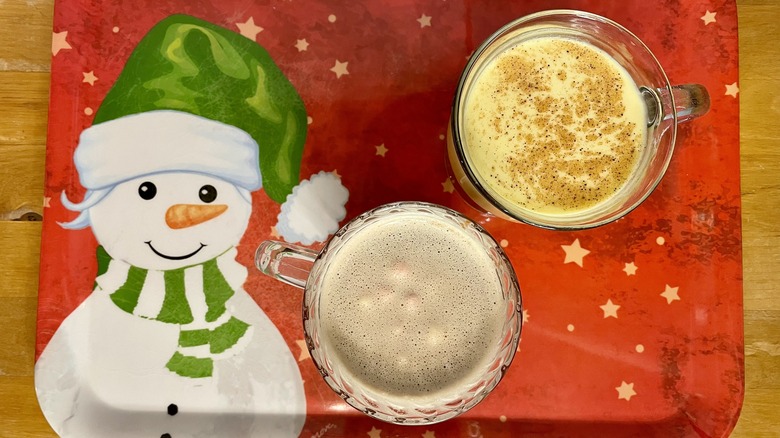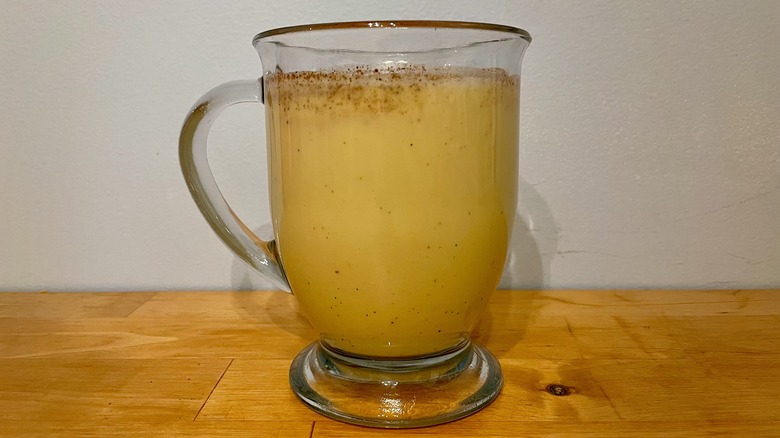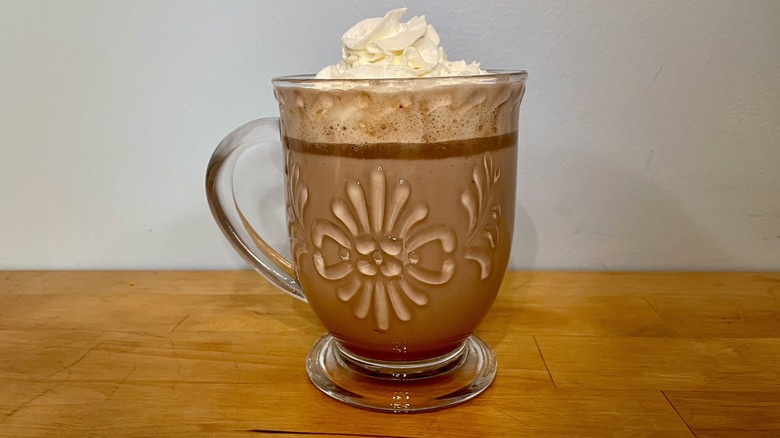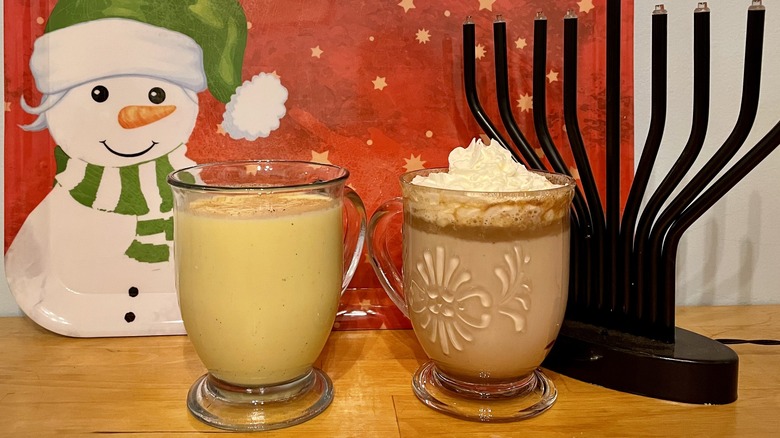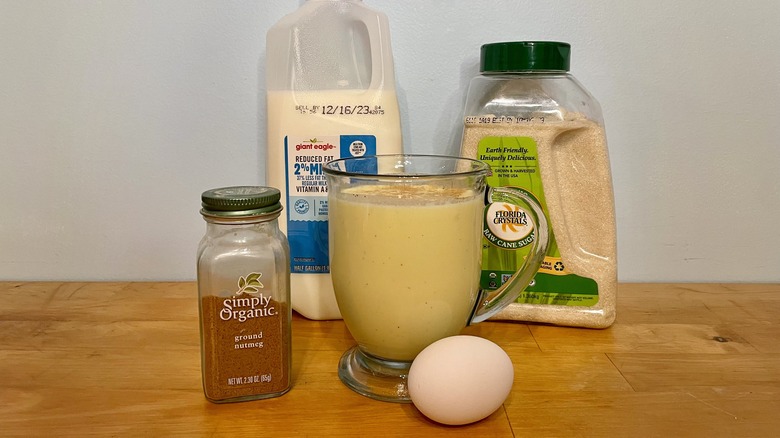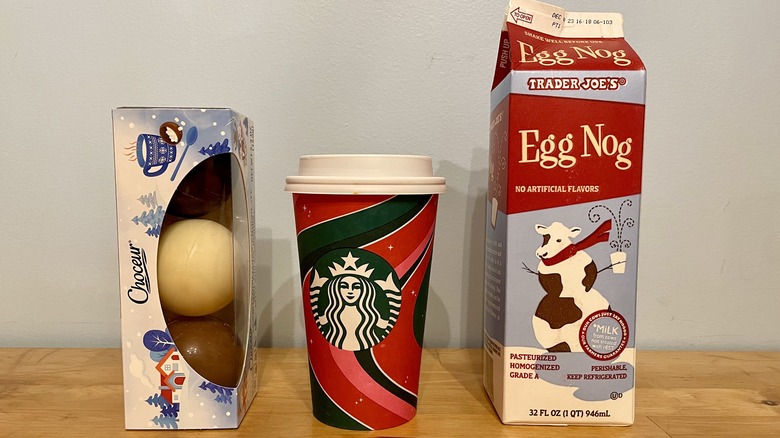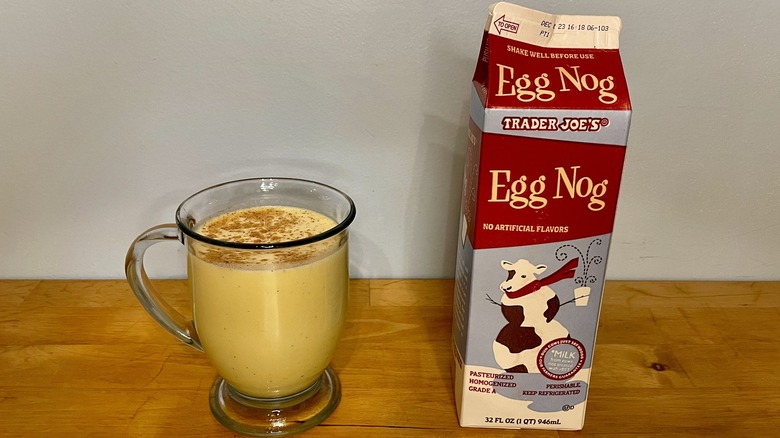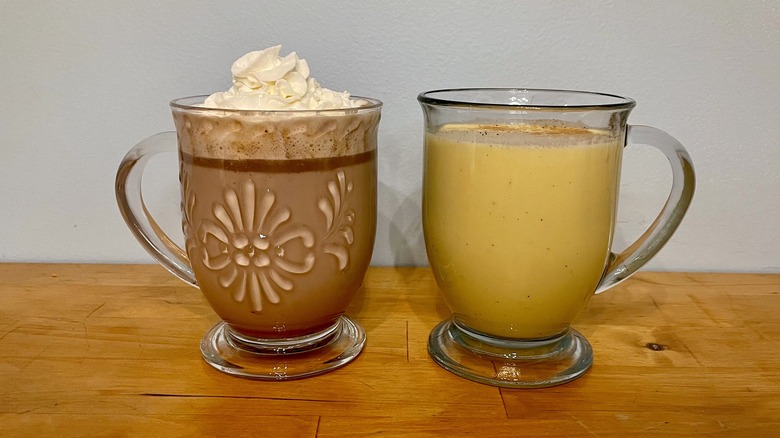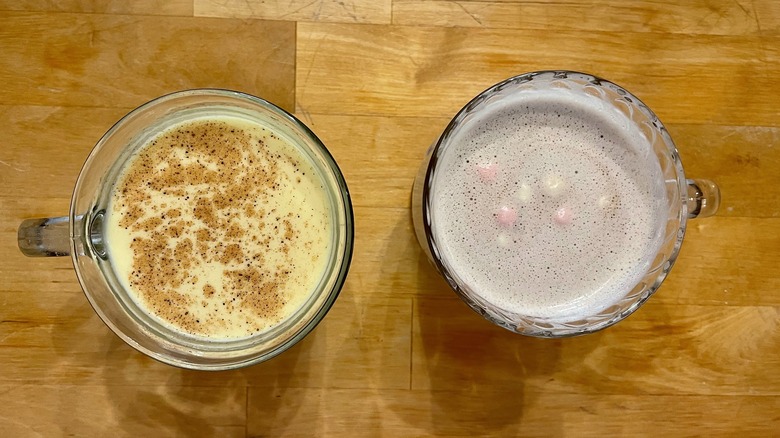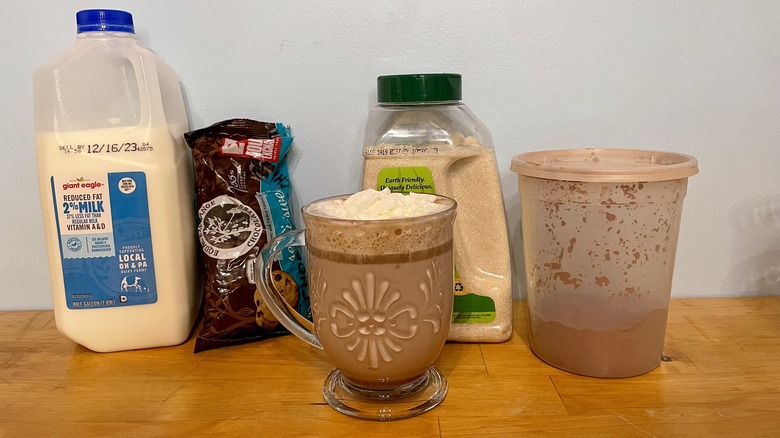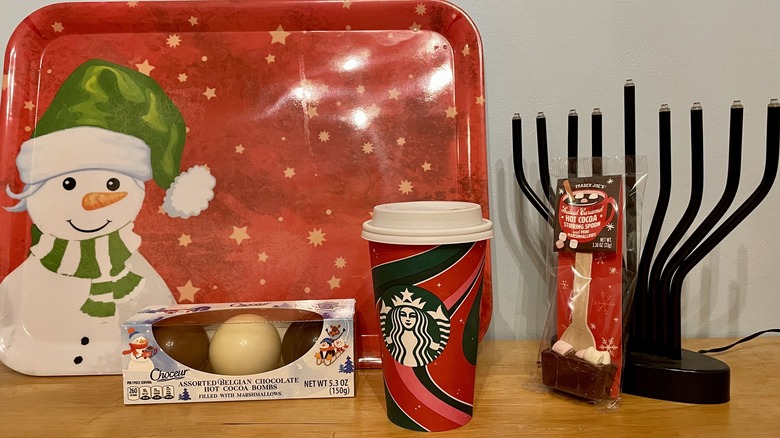Eggnog Vs Hot Chocolate: Which Is The Ultimate Holiday Drink?
Let's be honest: The best part of the holidays is all the delicious food that we get to eat. Between November and the end of December, there are a plethora of holidays for different religions and cultures, like Yule, Diwali, Hanukkah, Christmas, Kwanzaa, and the New Year. Each has unique traditions and foods that go with them.
To encompass all of this, we have the broadly defined holiday season, which has come to mean that time of year when almost everyone is celebrating something. With that has come food and drinks that have become associated with this festive season. Much like pumpkin spice has come to dominate fall, the warm drinks eggnog and hot chocolate arrive every year around this time. The two may come as seasonal favorites, but they are not equals. One drink is the superior holiday beverage of the two. We set out to find which one reigns supreme.
What's up with eggnog
Our first contender is eggnog, a drink where the name is not quite as enticing as it could be. The root of the name comes from egg, a key ingredient in the drink. As for nog, depending on who you ask, that could refer to either noggin, a wooden cup, or a type of beer known as grog. Considering the origins, either makes sense.
Eggnog is based on a medieval British drink called posset. Posset was made with milk and spices that were cut with wine or beer. This evolved into a more high-class drink where the beer was swapped for sherry and eggs were added.
Because of the expensive ingredients, eggnog was often considered a treat. The drink didn't become tied to the holidays until the 18th century when European colonists adapted it with ingredients that were available to them in the Americas, such as rum. It grew popular and George Washington famously served a boozy eggnog to his Christmas guests. Now, it is almost impossible to go to a holiday party without encountering eggnog. But does that make it an all-encompassing holiday drink?
Hot chocolate history
Hot chocolate as we know it today is newer to the scene compared to eggnog, but cacao-based drinks have been around for a while. The earliest known versions were made by the Mayan people of Mesoamerica for thousands of years. Hot chocolate-type drinks predate chocolate bars, though these early chocolate items were often unsweetened. Early versions of the drink were not even served hot. It was not until the 19th century that the drink evolved into a milky, sweet, and warm beverage.
Early, bitter chocolate drinks were more often used for religious or medical purposes, so how did they become associated with cheer and the holiday season? There isn't one clear answer. Having a creamy, warm drink to comfort you makes sense in the parts of the world where it is cold during the holidays. However, hot chocolate is still a part of Christmas culture in countries below the equator, such as Peru, where it can get warm during the holidays. So, that can't be the only reason. It could be the delicious taste or a capitalist ploy to sell more hot chocolate, too. Either way, hot chocolate is deeply tied to the holidays.
Creamy drinks two different ways
These two drinks may come out around the same time, but they are markedly different. The main thing that binds them is a base of milk or cream to create the right viscosity and taste. From there, though, the two differ dramatically.
Basic hot chocolate is made from milk, sugar, and melted chocolate. Cocoa powder can be added or entirely substituted for melted chocolate to make hot cocoa. A pinch of salt or splash of vanilla can also enhance the flavor, but neither is required. Different flavors can join the mix, and toppings such as marshmallows and whipped cream often top it all off.
Eggnog is a bit more complicated. Eggnog has eggs, typically in the form of yolks mixed with cream, milk, and sugar to create a thin custard. Nutmeg and vanilla are often added, and if you are keeping to tradition, a healthy dose of rum. Of course, hot chocolate can be boozed up, too, but that isn't usual.
In store-bought versions of the drinks, we see the same ingredients plus some extras. For instance, Trader Joe's hot cocoa mix includes sugar, milk powder, salt, calcium carbonate, xanthan gum, and flavors. Trader Joe's eggnog is made up of milk, cream, sugar, eggs, natural flavor, nutmeg, turmeric, annatto extract, and a selection of stabilizers.
One drink is easier to make
Once you have all the ingredients, there is a notable difference between hot chocolate and eggnog. First of all, hot chocolate can be found in several prepackaged, ready-to-make forms, such as powdered mixes, bombs, and sticks, all of which are ready to mix with hot water or milk. Even if you want to make it all from scratch, you can still just warm up milk, mix your ingredients in, and you are good to go. Hot chocolate can easily be made in a single serving and even in a microwave. Not so with eggnog.
The issue is the eggs. Not only are there fewer ready-to-make options available, but you have to cook it to ensure it is safe to drink. Eggnog is typically cooked slowly over medium heat in a heavy-bottomed pot. This cooks the egg and thickens the drink, but it also requires constant vigilance. If you don't keep the contents moving, you could end up with scrambled milky eggs. If you overcook it, you end up with custard. There is no getting around the laborious act of making eggnog, not to mention the fact you will have to dirty a pan too clean when you're finished.
Where to buy hot chocolate or eggnog
If you want to buy your holiday drink, we don't blame you. The holidays are hectic enough as it is, so go out and buy your cup of cheer. Even here, hot chocolate has eggnog beat by a mile. As we mentioned, instant hot chocolate options can be purchased at just about any grocery or convenience store. By contrast, instant eggnog is a specialty product that typically has to be ordered online.
If you want to buy eggnog, you can purchase bottled versions in the refrigerator section at many stores during the holiday season. However, this type of eggnog can vary in quality depending on the brand. Consider that, according to the FDA, a commercial eggnog only needs to have 1% egg in it.
You're unlikely to find eggnog at restaurant chains. While places such as Dunkin' and Starbucks offer hot chocolate, eggnog rarely finds its way to the menu. You may get the occasional eggnog-flavored latte, but for many, it just isn't the same as being served a fresh cup of eggnog.
Versions of both drinks are popular in other countries
Hot chocolate is popular in the United States but also other countries such as Peru and Ireland. However, there is not a lot of variation for holiday hot chocolate.
On the other hand, variations on eggnog show up in a host of related holiday drinks. In Mexico, rompope is nearly identical to the popular holiday drink. The Christmas drink called coquito in Puerto Rico is often touted as Puerto Rican eggnog. Coquito means "little coconut," and instead of using eggs, the drink relies on coconut cream for its thick consistency. In Scotland, Auld Man's Milk is a take on eggnog enjoyed around the New Year, while the similar eirlikor is found in Germany. Many of these versions of eggnog across the world include some form of alcohol, whether it be rum, scotch, or another liquor. It seems hard to avoid creamy drinks for the holidays.
How both drinks look
There is no denying that the colors of these two drinks are near opposites. While not entirely black and white, hot chocolate and eggnog are traditionally brown and cream-colored, respectively. Commercial eggnog typically has a soft cream color with a yellow hue from the egg yolks. Hot chocolate, on the other hand, is a rich, deep brown shade. The exact color depends on if you are using dark or milk chocolate.
As far as consistency goes, eggnog tends to be thicker than hot chocolate. This is particularly true if the hot chocolate in question is made from cocoa powder or a mix. These are thinner than ones made with melted chocolate. Both drinks are thicker and more rich than just plain milk.
Then, there is the matter of toppings. This can change depending on individual preference, but we opted for what many would consider to be traditional and festive toppings: marshmallows and whipped cream for the hot chocolate, and a cinnamon stick and sprinkle of spices for the eggnog. This gives the eggnog a subtler and somewhat more refined look. Meanwhile, the hot chocolate's whipped cream and marshmallow elicits imagery of snowy days and adds whimsy.
How they smell
In food and drink, smell is just as important as appearance, if not more so, given that it can dramatically affect how we perceive flavor. We first noticed that our hot chocolate had a more pronounced and easily-defined smell. The cup practically wafts its flavor toward you, drawing you into its sweet cocoa aroma. Part of this is likely due to the fact it is served warm. When food is warm, the smell more easily diffuses into the air, heightening the aroma. Chocolate is also often a powerful smell.
Eggnog is often served cold. It certainly comes that way from a grocery store. Because of this, even once it's been poured into a cup, you must actively work to smell it. Egg yolks and cream create a lovely consistency, but there just isn't that much to smell. Without alcohol in the mix, the eggnog's spices become the main scent. In this case, that was pretty much the only thing we could smell. That is fine and dandy, but just doesn't have the draw of warm chocolate.
Tasting the sweet treats
The first thing to understand is that, with each of these drinks, there will be a difference in flavor depending on whether it is homemade or store-bought. For simplicity's sake, we also stuck with non-alcoholic versions of both drinks.
The Trader Joe's eggnog was thinner than we anticipated, and we are not mad about it. It had the consistency of half and half, making it not quite as thick as heavy cream or homemade eggnog. This eggnog was light and creamy, with a subtle nutmeg flavor that proved pleasant and inoffensive. Homemade eggnog is thicker but can turn out grainy as it is easy to overcook.
The hot chocolate — also from Trader Joe's — was sweet with deep, earthy chocolate notes. Where eggnog is subtle, hot chocolate has a more bold flavor. Of course, different brands will have different levels of chocolate and sweetness. The Trader Joe's version was sugary but retained the richness of the cocoa.
Final verdict: eggnog falls short
At the end of the day, there has to be a winner. For us, that is hot chocolate. It's easier to find in restaurants and make at home. It's also been used for much longer, while it also generally tastes better. Some say that those who dislike eggnog haven't had a good variety, but if there is so much lousy eggnog out there, can it really beat out more popular hot chocolate? If people don't like hot chocolate, it is likely because they don't like chocolate. But there is not nearly as much public scrutiny for hot chocolate as there is for eggnog.
Additionally, hot chocolate is more sober-friendly and can be made to fit a plethora of dietary restrictions without changing the core ingredients. Vegans can simply swap to non-dairy milk, for instance. The stars of the show are chocolate and cocoa. Eggnog has to contain egg, even when using non-dairy milk.
Eggnog is also often served cold, which is not what we want on a cold winter night. Hot chocolate is more consistently delicious and loveable than its eggy competitor, ushering in the holidays in a more obviously delightful way.
